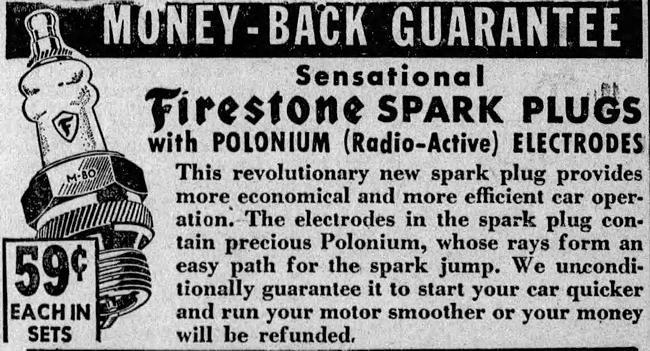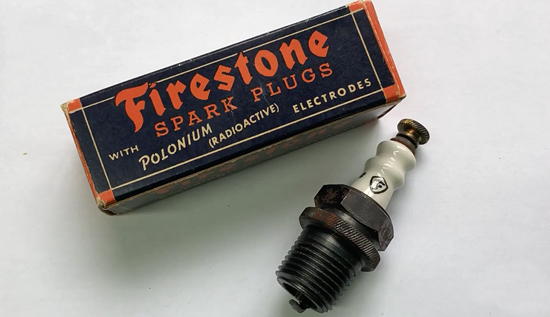Radioactive Spark Plugs
Firestone came out with radioactive spark plugs in 1940. The idea was that radioactive material (polonium) would improve the electrical conductivity of the spark plugs, resulting in better fuel combustion. More details from the Health Physics Historical Instrumentation Museum:


Other than the slightly improved performance when the plugs were first installed, their benefits were questionable. The short half-life of polonium-210 (138 days) meant that the enhanced performance was only temporary. It also put dealers in the uncomfortable position of having to decide what to do after unsold plugs sat on the shelf for extended periods. Furthermore, the inevitable accumulation of deposits on the surface of the plugs’ electrodes as the vehicle burned fuel would attenuate the alpha particles and prevent them from ionizing the gas.

Monrovia News-Post - Mar 27, 1941

Comments
Snake oil comes in many shapes and forms. And there will always be some idiot out there willing to part with his money to get some.
I've seen plug designs with multiple side electrodes claiming more complete burning and power gains. It turns out that there is no power gained with those designs. However, I see that the recommended plugs that I put into my '08 Ford 4 cylinder have multiple side electrodes, but they are there for longevity - replacement intervals are on the order of 75000 miles or more. You didn't get that with the old plugs.
I've seen plug designs with multiple side electrodes claiming more complete burning and power gains. It turns out that there is no power gained with those designs. However, I see that the recommended plugs that I put into my '08 Ford 4 cylinder have multiple side electrodes, but they are there for longevity - replacement intervals are on the order of 75000 miles or more. You didn't get that with the old plugs.
Posted by KDP on 01/13/21 at 09:42 AM
For those like me wondering the only decay product of polonium 210 is lead 206.
Posted by eddi on 01/14/21 at 10:17 PM
Commenting is not available in this channel entry.

Category: Atomic Power and Other Nuclear Matters | 1940s | Cars